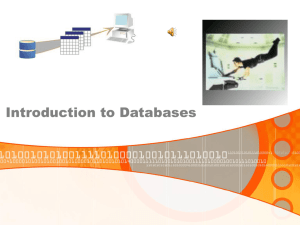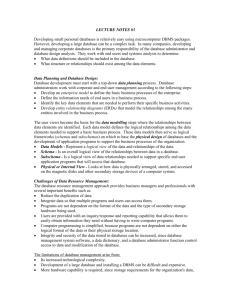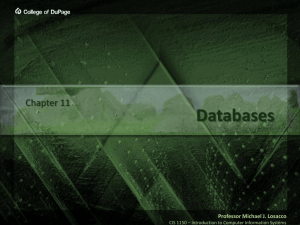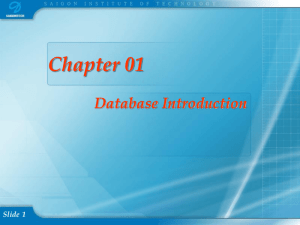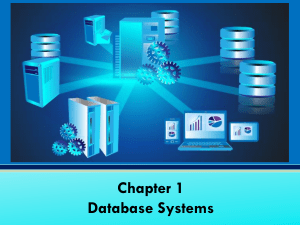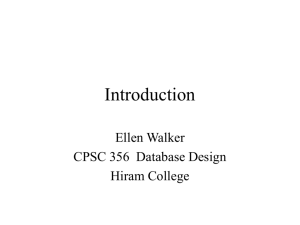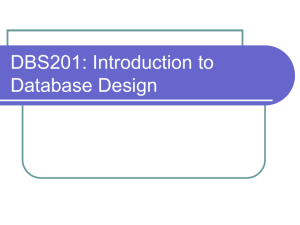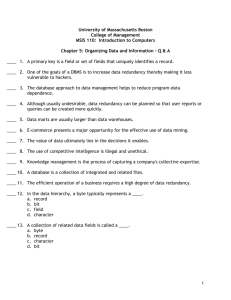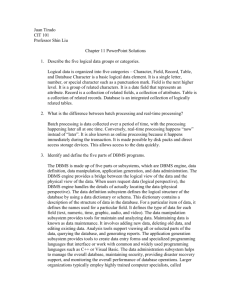CSC FUNDAMENTALS OF DATABASE MANAGEMENT SYSTEMS
advertisement
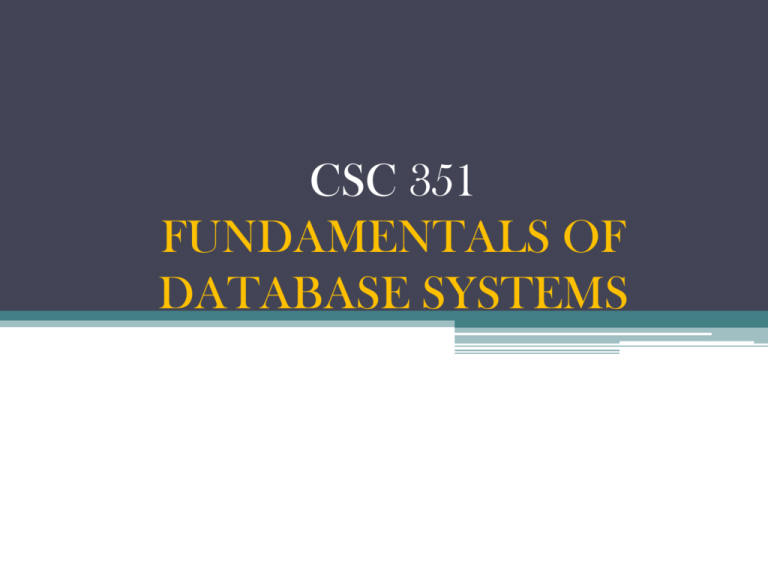
CSC 351 FUNDAMENTALS OF DATABASE SYSTEMS LECTURE 1: INTRODUCTION TO DATABASES • Databases are an essential component of modern society. • A database is a collection of interrelated data. • Properties of a Database: ▫ A database represents some aspect of the real world, sometimes called the miniworld or the universe of discourse (UoD). ▫ A database is a logically coherent collection of data with some inherent meaning. ▫ A database is designed, built, and populated with data for a specific purpose. **In other words, a database has some source from which data is derived, some degree of interaction with events in the real world, and an audience that is actively interested in its contents. • Database Management System (DBMS)is a set of programs to use and/or modify this data. Traditional File System • A file system is a method for storing and organizing computer files and the data they contain to make it easy to find and access them. File System Data Management (cont’d) • As number of files increased, file systems evolved ▫ Each file used its own application program to store, retrieve, and modify data ▫ Each file was owned by individual or department that commissioned its creation Problems with File System Data Management • Even simple file system retrieval task required extensive programming in 3GL ▫ Ad hoc queries impossible ▫ Changing existing structure difficult • Security features difficult to program therefore are often omitted in file system environments Problems with File System Data Management (cont’d) • The file system exhibits data dependence when changes in file data characteristics require changes in all programs that access the file. ▫ Data independence: data storage characteristics do not affect data access • A file system exhibits structural dependence when access to a file is dependent on its own structure ▫ All file system programs must be modified to conform to a new file structure ▫ Structural independence: change file structure without affecting data access Problems with File System Data Management (cont’d) • Data redundancy exists when the same data are stored unnecessarily in different places. • Uncontrolled data redundancy sets the stage for: ▫ Data inconsistency ▫ Data anomalies Data Redundancy (cont’d) • Data inconsistency exists when different and conflicting versions of same data appear in different places. • Data anomalies: abnormalities when all changes in redundant data are not made correctly ▫ Update anomalies ▫ Insertion anomalies ▫ Deletion anomalies Types of Database • Databases were developed as a result of the need to store and retrieve data, timely and accurately. • Databases can be classified according to: ▫ Number of users ▫ Database location(s) ▫ Expected type and extent of use • Number of Users ▫ Single-user database supports only one user at a time Desktop database: single-user; runs on PC ▫ Multiuser database supports multiple users at the same time Workgroup and enterprise databases Types of Databases (cont’d) • Location ▫ Centralized database supports data located at a single site ▫ Distributed database supports data distributed across several different sites • Expected type and extent of use ▫ Operational database: supports a company’s day-to-day operations ▫ Data warehouse: stores data used for tactical or strategic decisions Role of the DBMS • The DBMS receives all application requests and translates them into the complex operations required to fulfill those requests. • It hides much of the database’s internal complexity from the application programs and users. Advantages of the DBMS • Improved data sharing • Better data integration • Minimized data inconsistency • Improved data access • Improved decision making • Increased end-user productivity Contrasting database and file systems The Database System Environment • Database system: defines and regulates the collection, storage, management, use of data • Five major parts of a database system: ▫ ▫ ▫ ▫ ▫ Hardware Software People Procedures Data • Hardware: all the system’s physical devices • Software: three types of software required: ▫ Operating system software ▫ DBMS software ▫ Application programs and utility software The Database System Environment (cont'd) • People: all users of the database system ▫ System and database administrators ▫ Database designers ▫ Systems analysts and programmers ▫ End users • Procedures: instructions and rules that govern the design and use of the database system • Data: the collection of facts stored in the database The database system environment


